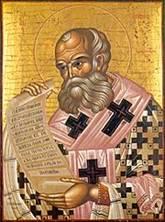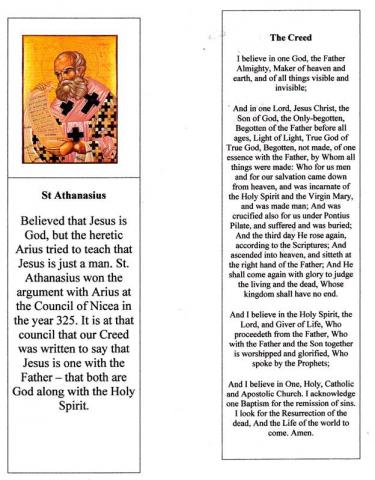St. Athanasius and the Creed
ST. ATHANASIUS AND THE CREED

Objectives:
- Students should know the story of St. Athanasius and be able to say his name.
- Students should be able to say the creed.
Possible Lesson Plan:
- Open with prayer.
- Tell the story of St. Athanasius (Have your maps ready to locate Alexandria and Nicea):
Athanasius was born at the end of the third century (How long ago was that?) in the city of Alexandria in Egypt. At that time, Alexandria was an important center of education and learning in the Roman Empire and its bishop an important leader in the Christian Church. One day, the bishop looked out his window and saw some small boys walking back and forth at the seashore. When he asked what they were doing, they said that they have made their friend, Athanasius, their bishop and are following his order to baptize the other children. Athanasius had taught the children all about Jesus and they were ready to follow the Lord! The bishop came to love Athanasius and the boy spent many hours in the bishop’s home reading and studying.
By the time he was 20 years old, Athanasius was writing books about the Lord. He believed that Jesus was truly God as well as truly man. But, another priest in Alexandria, named Arius, believed just the opposite. He believed that Jesus was a “superman” but not really God. He began to tell people that Jesus was a great hero. Even the Emperor Constantine heard of this great disagreement in the Christian Church and was upset by the arguments. So Constantine decided to hold a council of all the bishops. This council was held at Nicea in Asia Minor in 325 AD. Constantine himself was the presiding judge. Athanasius, still a young deacon, spoke to the bishops about the dangers of this new belief that Arius was spreading. Arius also spoke. Even Bishop Nicholas of Smyrna was present to defend true Orthodoxy along with Athanasius. The Council decided against Arius and wrote a creed, or statement of belief, that says, “Jesus Christ…being of one essence with the Father” to end the disagreement.
Athanasius became Bishop of Alexandria in 328 AD. But Arius was still alive and even the Emperor allowed Arius to keep teaching. Then he spread rumors that Athanasius had murdered a man. Athanasius went to Constantinople as a prisoner, but he showed them alive the man he was supposed to have killed! Even so, Athanasius was sent into exile – a prisoner in France for many years. When he finally came home to Alexandria, he again became Bishop. But, when a new Emperor arose who believed with Arius, Athanasius had to escape to Rome. He would try over and over to go back to Alexandria, only to have to flee – finally to the desert. But he never stopped writing about his beloved Jesus. Finally, as an old man, he was able to go home to Alexandria as its beloved bishop.
- Athanasius is called “The Great” by the Church. Why? He defended Jesus against false beliefs for many years. Think a bit about how important it is for Christians to know that Jesus is God. Have the students talk about superman (or spider man, batman, etc.) What are they like? What powers do they have? Are they God? What is different about God? Yes, Jesus was powerful and could walk on water, but His birth, death, and resurrection mean nothing if He was just another superhero! Athanasius would argue that only Jesus the God-man could have died for our sins; only if He were truly God and truly man would the crucifixion have meant anything at all.
- Practice the sign of the cross. The three fingers stand for God the Father, the Son, and the Holy Spirit. And the two fingers down on the palm stand for the 2 natures of Jesus – God and man – who came down to earth. Have the students practice. Do they know what the fingers stand for?
- Work on the creed. The memory work for the next few weeks is the Creed. Sing it together a few times. When do we sing it in liturgy? The Creed is a magnificent document. Even to this day, it is used by the Church to distinguish orthodox (true) belief from heresy. Some groups today use the word Christian or Christ but deny the creed; we know they are not truly Christian. For example, the Christian Scientists, following the teachings of Mary Baker Eddy, do not believe that Jesus was truly God nor in the Trinity. The Jehovah’s Witnesses believe in only God the Father – Jesus was a “superman”. And the Mormons (the Church of Jesus Christ of Latter Day Saints, founded by Joseph Smith) do not believe in the Trinity. All fail the test of the Creed, written by the Council of Nicea in 325 AD! Ask the students, if someone asked you to define your faith as a Christian, what would you answer? The Nicene Creed gives a full and adequate answer, elegant and simple.
- Play a learning game: Creed Bounce. Have a beach ball ready. Sit or stand in a circle on the floor. Begin with the first few words of the Creed. Bounce the ball to a student who continues for another line. He bounces the ball to another student… Do the Creed 2-3 times thru.
- Make a Creed Scroll: Athanasius was Bishop of Alexandria, in Egypt. Egypt was the home of papyrus, the first paper made of plant fibers soaked, pressed together, and dried. Scrolls were made by pasting together squares of papyrus to make a long, thin document that could be rolled up and stored or carried easily. A great improvement over stone tablets! Take some nice paper, preferably one with the fibers showing. We have a bit in the cabinet. Have each student write the Creed on his paper. Roll it up and tie with a ribbon. Have the student keep it with him or in the car to work on the creed! OR print the Creed Coloring book and have students color and take home. Put two of each "segment" on each page and the entire file will print duplex, flip on long side, with 2 books for each printing.
- Alternate Craft Idea: Creed bookmark. See pattern on the next page. Copy back and front in color and laminate or use contact paper to make waterproof.

Does the lesson happen to fall right around Nativity? Why not make a "Creed" ornament? Just print on white cardstock, fold, tape or glue together. The Creed is the Church's statement of belief -- about the Father, about Jesus, about the Holy Spirit, and about the Theotokos. But it begins with my own statement, "I believe".
- Close with prayer: Lord, help me to be strong in what I know is true, even when everyone else disagrees with me.